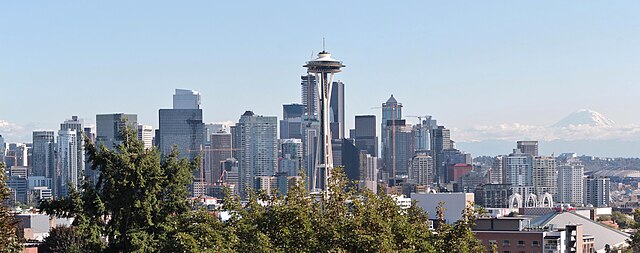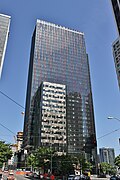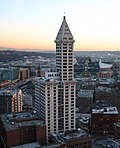Top Qs
Timeline
Chat
Perspective
List of tallest buildings in Seattle
List of skyscrapers and high-rise buildings in Seattle, Washington, U.S. From Wikipedia, the free encyclopedia
Remove ads
Seattle is the most populous city in the U.S state of Washington and the Pacific Northwest region of North America, with a metropolitan area population of over 4 million. It is home to 53 completed high-rise buildings over 400 feet (122 meters), of which 21 are over 500 ft (152 m) tall.[1] Seattle's skyline is one of the largest on the West Coast of the United States, and is by far the largest in the Northwestern United States.[2] The tallest building in Seattle is the 76-story Columbia Center, which rises 937 feet (286 m) and was completed in 1985.[3] It is currently the 41st-tallest building in the United States, and the tallest building in the state of Washington.[4]

The history of skyscrapers in Seattle began in the late 19th century, with early construction spurred on by money from the Klondike Gold Rush and the Alaska–Yukon–Pacific Exposition.[5][6] One noteworthy early skyscraper was the neoclassical Smith Tower, a 38-story, 462 ft (141 m) building completed in 1914. It was the tallest building west of the Mississippi River until from its completion until 1931.[7] A building boom in the 1920s was followed by a lull in high-rise development from the 1930s until the late 1950s, much like other major cities in the country. Seattle's world's fair, the Century 21 Exposition in 1962, contributed to the revival of the city's downtown.[8] The Space Needle, perhaps the city's most recognizable landmark,[9] was built for the fair as part of the Seattle Center. A 605 ft (184 m) tall observation tower, it was the tallest structure in the city until 1969, as another construction boom began.
The period between the 1960s and the early 1990s would see the addition of many notable commercial skyscrapers. The rate of development was particularly high during the 1980s, during which the city's third and fourth-tallest buildings, 1201 Third Avenue and Two Union Square, were built. Following another downturn in the 1990s, development would resume with the IDX Tower and WaMu Center in the 2000s. In recent years, Seattle has undergone a significant amount of high-rise development.[10] The neighbourhood of Denny Triangle has received an influx of residential towers since Amazon's relocation of their headquarters there in 2012,[11] and the skyline has also expanded northwards to South Lake Union and westwards towards Belltown. Seattle's second tallest building, Rainier Square Tower, was completed in 2021.
The majority of tall buildings in Seattle are located in downtown, with several high-rises extending the skyline towards South Lake Union. There are also a number of towers in the area of First Hill, which is separated from the rest of the downtown skyline by Interstate 5. Additionally, there are a cluster of high-rises in University District to the north, as new residential towers have been built near UW Tower since the late 2010s. In Seattle's wider metropolitan area, the city of Bellevue, east of Seattle across Lake Washington, has a notable skyline of its own.
Remove ads
History
Summarize
Perspective
Early high-rises

After the Great Seattle Fire of June 6, 1889, Seattle began reconstruction of the city's central business district under a new building code requiring the use of fireproof materials, such as stone and brick. By the end of 1890, 465 buildings had been built, completing the initial phase of reconstruction, and city boosters looked to build modern high-rise buildings after the infusion of new money from the Klondike Gold Rush later that decade.[5][6] The Pioneer Building, whose observation tower surpassed 110 feet (34 m), was completed in 1892 and is regarded as the city's first modern high-rise building.[12][13] The Alaska Building, completed in 1904 and rising 203 feet (62 m) above 2nd Avenue in Pioneer Square, is considered to be Seattle's first skyscraper and first steel-framed high-rise building. It held the title of tallest habitable building in the city until the completion of the 205-foot (62 m), 18-story Hoge Building in 1911.[14][15] Both buildings had been surpassed in height by the clocktower of King Street Station, opened in 1906, which stands 245 feet (75 m) tall.[16]
Seattle's continued growth at the turn of the century, bolstered by the Alaska–Yukon–Pacific Exposition in 1909 and the opening of the Metropolitan Tract to development, led to a building boom north of Yesler Way in the modern-day downtown.[17] On July 4, 1914, firearm and typewriter magnate Lyman Cornelius Smith opened the 484-foot-tall (148 m) Smith Tower, the city's new tallest building. For several years, the 38-story tower would hold the title of tallest west of the Mississippi River, and dominate the Seattle skyline.[7] By the end of the 1920s building boom, several new Art Deco high-rises above 200 feet (61 m) were completed in Seattle, including the Medical Dental Building (1925), Seattle Tower (1930), Roosevelt Hotel (1929), Washington Athletic Club (1930), Textile Tower Building (1930), Harborview Medical Center (1931), and Pacific Tower (1933).[18]
Post-war
New high-rise construction in Seattle was halted during the Great Depression and World War II, and slowed during the post-war economic boom in the 1950s, as suburbanization took hold in the region.[17][19] The first new building in downtown to be built after the war was the Norton Building in 1959, a 19-story office building in the International Style with a glass curtain wall and simple exterior features, a departure from the previous Neo-Gothic and Art Deco styles used in high-rises.[12][20] By 1959, office space occupying downtown buildings had overtaken retail uses, with over 4,987,000 square feet (463,300 m2).[21] Seattle was selected to host the World's Fair in 1962, revitalizing the downtown area and bringing the construction of the fairgrounds' centerpiece, the Space Needle. The 605-foot (184 m) observation tower became the symbol of the fair and a landmark for Seattle, and was the first new structure to surpass the Smith Tower in height.[17][22]

The 50-story Seafirst Building (now Safeco Plaza) became the city's tallest when it opened in 1969, standing 630 feet (190 m), and signaled the start of a major construction boom in Downtown Seattle.[18][12] The boom would last well into the 1980s, despite an economic downturn caused by the Boeing bust and 1970s energy crisis, and introduce elements of Modernist and Postmodern architecture to high-rise construction in the city.[23] During this period, 15 skyscrapers taller than 400 feet (122 m) in height were constructed in Seattle, including 901 Fifth Avenue (1973), the Henry M. Jackson Federal Building (1974), 1600 Seventh Avenue (1976), Rainier Tower (1977), 1111 Third Avenue (1980), the Westin Building (1981), 800 Fifth Avenue (1981), Union Square (1981 and 1989), and the First Interstate Center (1983).[18][17] In total, more than 14 million square feet (1,300,000 m2) of office space was added by new construction in the 1980s.[19] In 1984, the 76-story, 943-foot (287 m) Columbia Center was completed, becoming the tallest building in Seattle and on the West Coast of the United States.[18][12] During the 1980s, the suburb of Bellevue emerged as an urban center, boasting a skyline of its own that would continue to grow well into the 21st century.[24]

The boom of the 1980s was capped by the Columbia Center and other downtown towers such as 1000 Second Avenue (1987), 1201 Third Avenue (1988), the Pacific First Centre (1989) and the Gateway Tower (1990),[18][17] with new downtown office space in the decade surpassing what had been built over the previous 100 years in Seattle.[25] The new wave of development sparked fears of "Manhattanization" in downtown that would push out lower-income residents and reduce quality of life.[12][26] A downtown land use plan adopted in 1984 and shelved until 1986 required the addition of public benefits for major construction projects. Opposition to the new downtown plan, which would allow "generous" new construction unhindered by a height limit,[27] led to the creation of the "Citizen's Alternative Plan", which would limit buildings to 450 feet (140 m) and restrict development to an annual limit of 1 million square feet (93,000 m2) of space per year. The plan was approved by voters as a ballot initiative on May 16, 1989, replacing the land use plan and introduced the city's modern design review process for new development.[12][28][29]
1990s and 2000s
Development of new high-rises slowed down across U.S. cities during the early 1990s recession as demand caught up to an over-built market,[30] with Seattle's 1980s office buildings suffering from a lack of tenants that forced ownership changes or the threat of bankruptcy and foreclosure.[31] By 1992, vacancy rates for office space in Downtown Seattle reached 14.7 percent, while vacancy rates in outlying suburbs remained much lower.[32] The dot-com bubble of the late 1990s, including a local economy boosted by Boeing and Microsoft, led a cut of the vacancy rate to 6 percent by 1997;[33] between 1997 and 1999, new office buildings created an average of 1.5 million square feet (140,000 m2) of additional office space per year.[34] After the burst of the dot-com bubble and the early 2000s recession, downtown office vacancies shot up from 1 percent to 13 percent by the end of 2001.[35]
Two major downtown projects, the IDX Tower (2003) and WaMu Center (2006), were completed during the early 2000s and were the first office buildings to be built since the Key Tower in 1990.[36] By the mid-2000s, office vacancies in Downtown Seattle improved to below 10 percent, but office developers were hesitant to break ground on new projects.[37][38] A new downtown zoning plan adopted in 2006 effectively repealed the 1989 Citizens' Alternative Plan and its modified 540-foot (160 m) height limit, favoring unlimited heights in downtown and 400-foot (120 m) residential towers on the periphery of downtown.[39] The new zoning plan set off a wave of high-rise residential development in the late 2000s, including the completion of Fifteen Twenty-One Second Avenue (2008), Escala (2009), and Olive 8 (2009), coming at the peak of the United States housing bubble and the demand for downtown luxury condominiums before the Great Recession.[40][41]
Post-recession boom
During the Great Recession, downtown office vacancies rose to a record 21 percent by the beginning of 2010,[42] but dropped to 10 percent by 2013;[43] the downturn was partially blamed on the collapse of Washington Mutual, which employed 3,500 in its downtown offices.[44] The surge in demand for office space revived several downtown high-rise office projects, including The Mark and Madison Centre, both exceeding 500 feet (150 m) in height and planned to open in 2017.[45] Other planned office and mixed-use buildings in Downtown Seattle include 2&U, the stalled Civic Square project, and the Rainier Square Tower, the city's second-tallest building at 850 feet (260 m).[18][46] Since 2010, developers have also sought to build high-rise residential towers in Downtown Seattle, including a supertall 101-story tower named 4/C, which would become the city's tallest building at 1,029 feet (314 m),[47] and the 880-foot (270 m) 888 Tower.[48]
Recent high-rise development in Seattle has been concentrated in the Denny Triangle and South Lake Union areas to the north of Downtown Seattle, both rezoned to support development in the 2000s after decades of supporting industrial and low-rise commercial establishments.[49][50] Office development came first to the Denny Triangle area in the mid-2000s, with the construction of the United States Courthouse (2004) and 1918 Eighth Avenue (2009).[18] In 2012, Amazon.com announced their intention to relocate their South Lake Union headquarters to a complex of high-rises in Denny Triangle;[51] the first towers, the 520-foot (160 m) Doppler and Day 1, opened in 2016, and at least three more towers are in development.[52] The Denny Triangle also hosts the region's largest hotel, the 45-story Hyatt Regency Seattle near the Washington State Convention Center, which was completed in 2018.[53]
Residential developments in the Denny Triangle area above 400 feet (120 m) include Aspira (2010), Premiere on Pine, Cirrus, Kinects, Stratus, McKenzie Apartments, and AMLI Arc.[18] The Denny Way corridor in South Lake Union, upzoned in 2013 by the city council, has at least seven high-rise residential buildings above 400 feet (120 m) in height, including the completed Kiara and 1120 Denny Way.[54] Other parts of downtown Seattle have also been host to recent high-rise residential development, including the twin Insignia Towers in Belltown, Tower 12, Helios, and West Edge Tower near Pike Place Market.[18]
Remove ads
Tallest buildings
Summarize
Perspective
This list ranks Seattle skyscrapers that stand at least 400 feet (122 m) tall, based on standard height measurement. This includes spires and architectural details but does not include antenna masts. The "Year" column indicates the year in which a building was completed. Freestanding observation towers, while not habitable buildings, are included for comparison purposes; however, they are not ranked.
Remove ads
Tallest under construction or proposed
Summarize
Perspective
Under construction
This lists skyscrapers that are under construction in Seattle that are expected to rise over 400 feet (122 m), but are not yet completed structures.
Approved
This lists skyscrapers that are approved for construction by the Seattle Department of Construction and Inspections that are expected to rise over 400 feet (122 m), but have not started excavation.
* Table entries without text indicate that information regarding one or more of building heights, floor counts, and dates of completion has not yet been released.
Proposed
This lists skyscrapers that are proposed for construction in Seattle that are expected to rise over 400 feet (122 m), but are not yet completed structures.
* Table entries without text indicate that information regarding one or more of building heights, floor counts, and dates of completion has not yet been released.
Remove ads
Timeline of tallest buildings
This lists buildings that once held the title of tallest building in Seattle. The Space Needle is not a building, and is thus not included in this list; the 605-foot (184 m) tower was the tallest structure in the city from 1961 to 1969.
Remove ads
Notes
- C. ^ The Space Needle is not a habitable building, but is included in this list for comparative purposes. Per a ruling by the Council on Tall Buildings and Urban Habitat, freestanding observation towers are not considered to be buildings, as they are not fully habitable structures.
- D. ^ The height of the Pioneer Building was reduced to 92 feet (28 m) after the 1949 Olympia earthquake.
References
External links
Wikiwand - on
Seamless Wikipedia browsing. On steroids.
Remove ads






















































